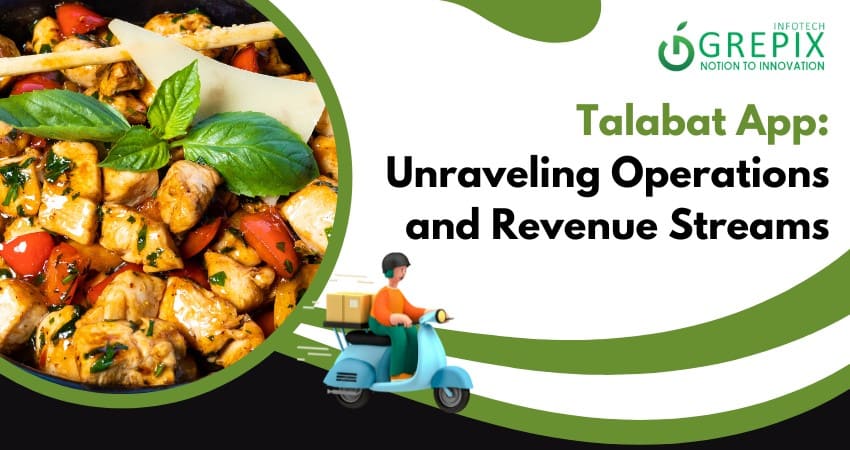Talabat app : Unraveling Operations and Revenue Streams
In the realm of food delivery apps, one standout in the UAE market is Talabat. This app simplifies the food ordering process, allowing users to effortlessly order from nearby or popular restaurants with just a few clicks. The added perk? Your chosen meal is brought straight to your doorstep, eliminating the need to wait in line. Talabat makes dining-in a breeze!
For users, navigating the app is a breeze, but for entrepreneurs, comprehending the inner workings of Talabat is essential. Without a grasp of this on-demand business model, venturing into a competitive market becomes daunting. Acquiring a fundamental understanding is the key first step for entrepreneurs in this dynamic landscape.
In this article, we delve into the intricacies of the Talabat business model, unraveling the simplicity of how Talabat operates. Additionally, we scrutinize the revenue streams of Talabat, offering you a straightforward insight into the profit dynamics at play.
Discover the success story of Talabat! Dive into our latest article, where we unravel the remarkable journey of the UAE's leading food delivery app, Talabat. From its humble beginnings in 2004 to becoming a dominant force in the Middle East, we explore its operational strategies, innovative revenue models, and the comprehensive benefits it offers to users, restaurants, and delivery personnel. Whether you're an entrepreneur looking to enter the digital food delivery space or a foodie curious about the workings behind your orders, this insight-packed piece is a must-read!
Talabat's Journey in the UAE Food Delivery Scene
Talabat stands as a prominent name in the food delivery industry of the UAE, gaining substantial acclaim in the Middle East. This journey began in 2004, when a visionary group of entrepreneurs in Kuwait aspired to simplify food delivery for everyone, leading to the birth of Talabat.
In those early days, high-speed internet like 4G or 5G was a thing of the future, resulting in less reliable network connections. Additionally, the convenience of online road maps, which now help in navigating to destinations accurately, was not available.
Talabat has successfully navigated these challenges and now operates extensively across the MENA region. It boasts an impressive roster of over 5500 eateries and restaurants for customers to choose from.
Every year sees the launch of countless new food ventures, yet not all can sustain themselves in the competitive on-demand economy. Talabat, however, stands out in this race. Despite the fierce competition in the UAE's food market with numerous industry giants, Talabat consistently holds a leading position.
Key Milestones of Talabat
- Talabat expanded its digital presence by launching mobile apps for both Android and iOS users in 2012.
- In 2015, the company caught the attention of Rocket Internet, a German e-commerce giant, and was acquired for a remarkable $170 million.
- The following year, in 2016, Talabat became part of Delivery Hero, a leading online food marketplace, marking a new chapter in its ownership.
- A significant move occurred on March 4, 2019, when Talabat acquired Zomato's UAE operations for $172 million, integrating Zomato's user base into its own platform.
- A crowning achievement was in 2020, when Talabat was selected as the official food provider for
- Expo 2020, introducing innovative concepts like cloud kitchens.
- Dominating the UAE food delivery market, Talabat holds an impressive 78% market share and boasts the highest order volume among the Middle East's digital food delivery platforms.
Talabat's Operations Model
- Talabat functions through three main channels: for users, restaurant partners, and delivery riders.
- Users begin by signing up on the Talabat app or website, then they can browse and order from restaurant menus. Payment for orders is facilitated through various options.
- Restaurant partners have a dedicated panel to register and verify their businesses. Once verified, they can list their menus and manage orders, which are then confirmed by an admin and assigned to a delivery person.
- Delivery riders use the Talabat Rider App to register and get verified by the admin. Once approved, they receive delivery tasks and start earning.
Talabat's Role in the Market
Talabat plays a significant role in the food delivery market by connecting customers with a wide range of restaurants and enabling them to order food online. Here are some key aspects of Talabat's role in the market:
- Online Food Delivery Platform: Talabat serves as an intermediary between customers and restaurants. It provides an online platform and a mobile app that allows users to browse menus, place orders, and have food delivered to their doorstep.
- Restaurant Partnerships: Talabat collaborates with a diverse array of restaurants, including local eateries as well as international chains. This broad range of choices enhances the platform's appeal to a wide customer base.
- Convenience: Talabat adds convenience to the food ordering process. Customers can explore various cuisines, compare prices, and place orders with just a few clicks, saving them time and effort.
- Delivery Logistics: Talabat manages the logistics of the delivery process. This includes coordinating with restaurants, dispatching delivery drivers, and ensuring that orders are delivered promptly and accurately.
- Market Presence: Talabat's presence in multiple countries in the Middle East positions it as a major player in the regional online food delivery market. Its established brand and user base contribute to its influence in shaping consumer behavior in the food delivery space.
- Technology Integration: Talabat leverages technology to enhance the user experience. This includes features such as real-time order tracking, secure payment options, and personalized recommendations based on user preferences.
- Competition: The online food delivery market is competitive, with various players vying for market share. Talabat competes with other platforms to attract both customers and restaurant partners. Continuous innovation and improvements in services are crucial to staying competitive.
Talabat's Revenue Model
Understanding Talabat's revenue model reveals how the platform profits.
Commission Model
- Talabat charges restaurants a fee of 15-25% on each order, based on various factors like order frequency, location, market penetration, and competitiveness.
Delivery Charge Revenue
- No minimum order requirement allows for broader order acceptance. However, delivery fees may increase during peak times or special occasions, contributing significantly to Talabat's earnings.
Talabat's Revenue Model
Talabat employs two main advertising tactics banner ads and priority listings
- Banner Ads: This involves displaying ads of restaurants on the app's banner, aiming to boost their visibility and reach.
- Priority Listings: Restaurants can opt for a prioritized position in listings, increasing their chances of attracting more users.
Restaurants, especially new or smaller ones seeking to expand their customer base, can leverage Talabat's restaurant affiliate marketing strategy. Talabat charges a fee for restaurants to feature in their ad spaces on the website and app.
The cost for priority listings varies, with higher visibility spots attracting higher fees. This approach significantly enhances Talabat's revenue, making advertising a key element in sustaining a stable income for online food delivery businesses.
Features of Talabat App
User App
- Downloadable from Google Play or Apple App Store.
- Login or registration for account access.
- Filters and sorting options for food and restaurant exploration.
- Customizable orders with ingredient preferences.
- Secure online payment options.
- Order tracking with estimated delivery times.
- Option to schedule orders for later.
- Favorite' feature for quick access to preferred restaurants.
- Notifications for new menus, discounts, and more.
Delivery Person’s App
- Easy login and profile setup.
- Document upload for profile verification.
- Management of delivery requests.
- Built-in map navigation for efficient deliveries.
- Availability status updates for admin visibility.
- Income tracking history.
- User feedback reception.
Restaurant Panel
- Interactive dashboard with various management tools.
- Option to accept or decline orders.
- Profile management including logo, business hours, menus, discounts.
- Access to earnings reports for profit analysis.
- Cost to Develop an App Like Talabat.
- App size.
- Target platform (Native or cross-platform).
- Feature complexity.
- Graphical interface design.
- Development team choice (in-house or offshore).
- Post-launch support and maintenance.
An estimated cost range for building such an app is between $15,000 and $45,000, subject to the app's complexity and chosen advanced features.
Conclusion
And that wraps up our discussion for today. Through this exploration of Talabat's journey, we see its remarkable evolution into a leading force in the Middle East's meal delivery sector. With the global meal delivery market expanding swiftly, there's a wealth of opportunity for food delivery enterprises to tap into substantial revenue streams by embracing digital platforms.
For entrepreneurs aiming to scale their food delivery ventures, adopting a mobile app platform similar to Talabat's model is a strategic move. This approach not only reaches a broader audience but also maximizes profitability, proving to be a smart choice for forward-thinking businesses.
Get an application similar to Talabet or Talabet Clone App, empowering entrepreneurs to oversee their businesses in real-time and effortlessly expand them across multiple regions.







